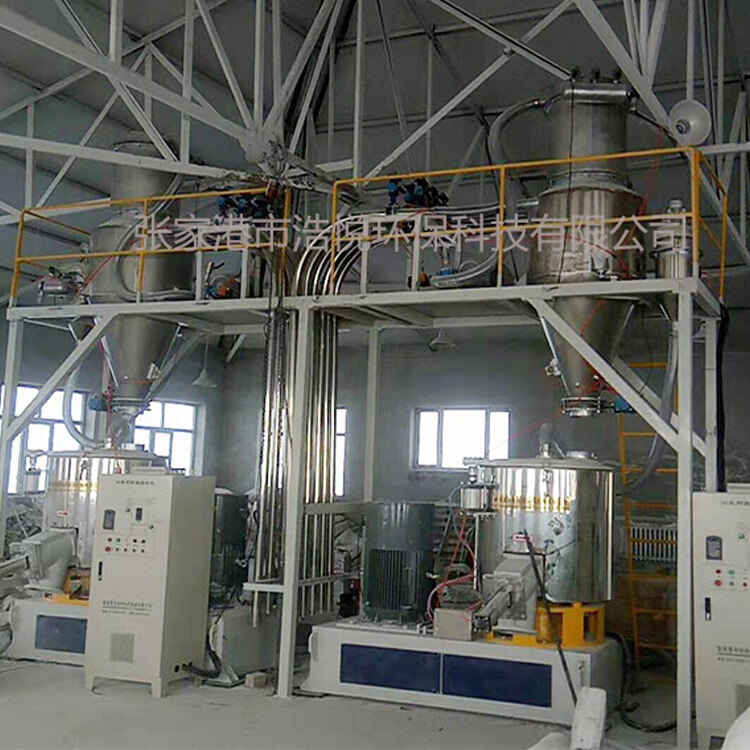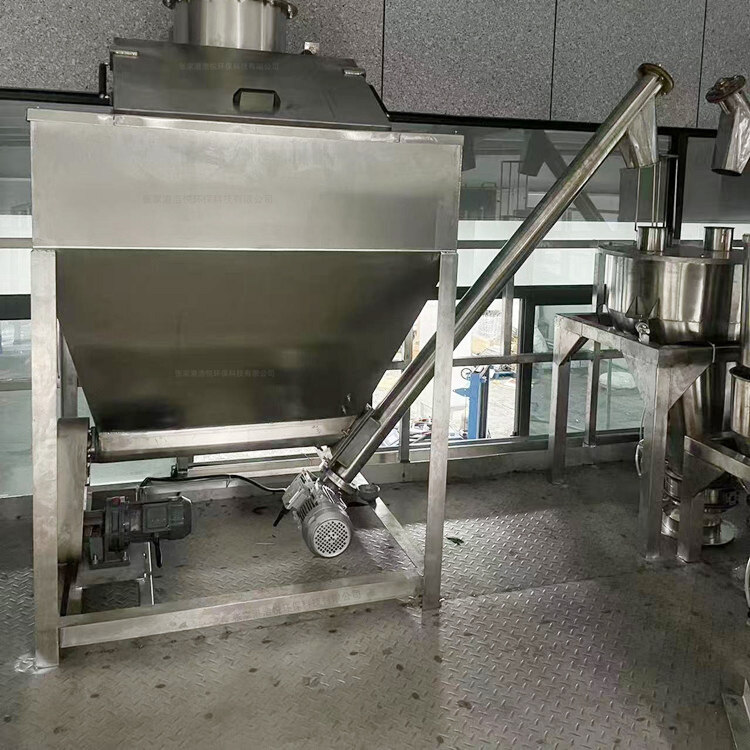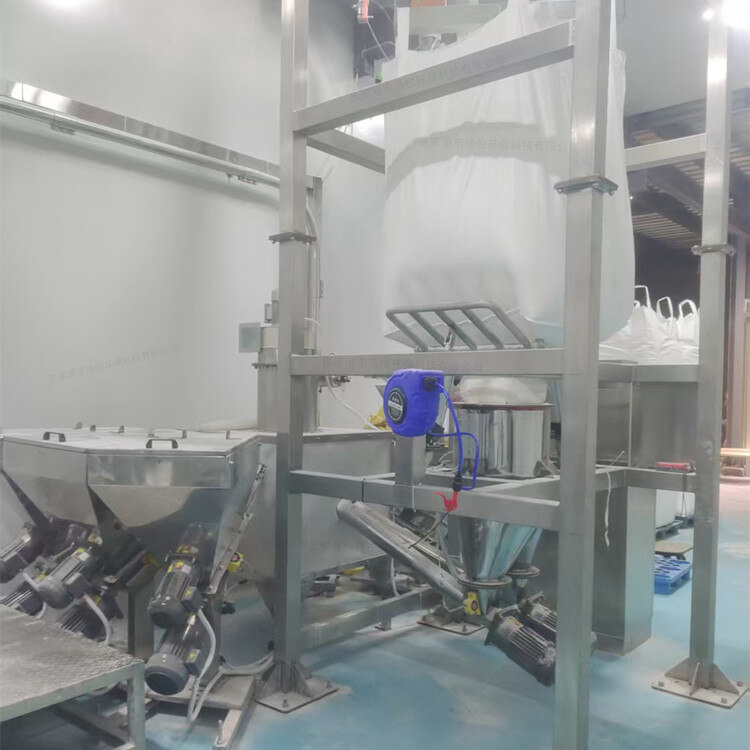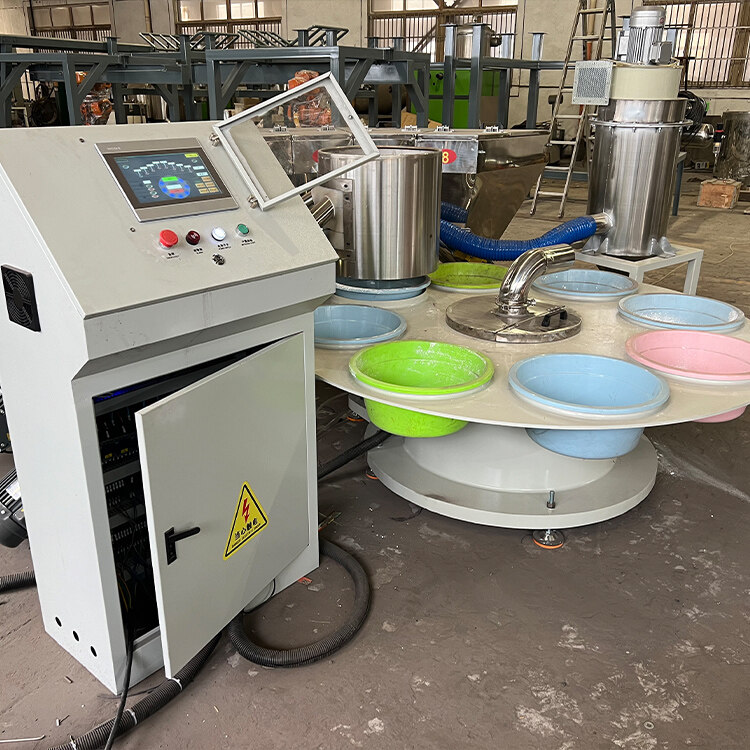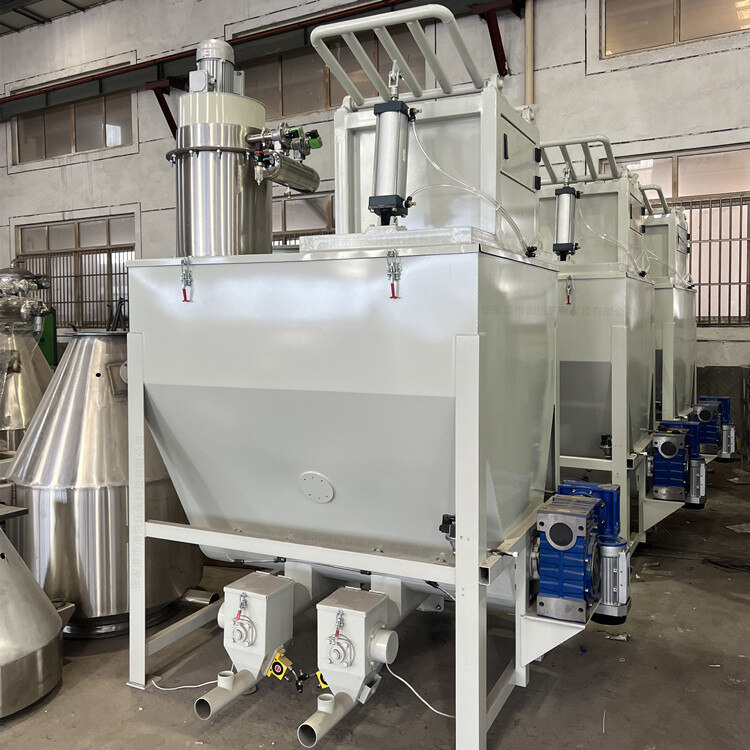- Introduction to automatic batching machine and fully automatic batching machine equipment
- The powder metering system tells you about the introduction of the mixing and drying machine
- 1000kg vacuum feeding machine
- Fully automatic small material batching system
- Research on Innovation of Automatic Weighing Machine Technology
- Design and operation of automatic batching system using PLC, industrial computer and frequency converter
High Speed Mixer
- Category:Mixer
- Hits:105次
- Release Date:2025-06-30
- Share:
- Inquiry
- Details
In industrial production, uniform mixing of materials is a key link in ensuring product quality and production efficiency. As an efficient material mixing equipment, high-speed mixers are widely used in various fields such as chemical, food, pharmaceutical, and building materials due to their unique structural design and powerful mixing performance. It can quickly and uniformly mix materials of different properties and particle sizes in a short period of time, meeting the high-precision and high-efficiency requirements of modern industrial production for material mixing. The following will provide a comprehensive and in-depth introduction to high-speed mixers from the aspects of device structure, working principle, core advantages, application scenarios, and development trends.
1、 Core structure composition of equipment
The high-speed mixer is mainly composed of six core components: mixing container, stirring device, driving system, heating/cooling system, control system, and unloading device. These components work together to form an efficient mixing system.
(1) Mixing container
The mixing container is the main component of the high-speed mixer that carries materials. It usually adopts a cylindrical or U-shaped structure and is made of stainless steel, carbon steel, or specific corrosion-resistant materials. It is selected according to different production needs and material characteristics. The inner wall of the container is smooth, reducing material residue. Some containers also undergo mirror polishing treatment for easy cleaning and maintenance. The capacity of the container is designed according to the production scale, ranging from laboratory mixers of a few liters to industrial production mixers of several cubic meters, to meet the needs of different users. In addition, the top of the container is equipped with a feeding port, which facilitates the input of materials; There is a discharge port at the bottom for discharging materials after mixing is completed. The opening and closing methods of the discharge port include manual, pneumatic, and electric, which can be selected according to actual production needs.
(2) Mixing device
The mixing device is a key component of a high-speed mixer for material mixing, mainly composed of a mixing shaft and mixing blades. The mixing shaft is generally made of high-strength alloy steel, which has sufficient strength and rigidity to withstand the torque and impact force generated during high-speed rotation. The shapes and structures of stirring blades are diverse, commonly including paddle type, turbine type, dispersing disc type, serrated type, etc. Paddle blades are suitable for mixing low viscosity materials; Turbine blades can generate strong shear forces and are suitable for materials with medium to high viscosity; Dispersed disc and serrated blade are mainly used for material dispersion and refinement, commonly used in industries such as coatings and inks. The number, installation angle, and speed of the mixing blades will be optimized according to the characteristics of the material and mixing requirements to achieve the best mixing effect.
(3) Drive system
The drive system provides rotational power for the mixing device, mainly composed of components such as motors, reducers, couplings, and pulleys (or gears). As a power source, three-phase asynchronous motors or variable frequency speed regulating motors are often used. Choose the appropriate model and power according to the power requirements and usage scenarios of the mixer. Variable frequency speed regulating motors can achieve stepless adjustment of mixing speed, meeting the speed requirements of different materials at different mixing stages. Reducer is used to reduce the speed of the motor and increase the torque, so that the mixing shaft can operate at a suitable speed. Common types of reducers include cycloidal pinwheel reducers, gear reducers, etc. Couplings are used to connect the motor output shaft and the gearbox input shaft, ensuring smooth power transmission; The pulley or gear transmits the power of the reducer to the mixing shaft, achieving high-speed rotation of the mixing shaft.
(4) Heating/cooling system
The heating/cooling system is set according to the mixing process requirements of the materials to control the temperature during the mixing process. The main heating methods include electric heating, thermal oil heating, and steam heating. Electric heating converts electrical energy into thermal energy by installing electric heating elements on the outer wall of the mixing container, and heats the material. It has the characteristics of fast heating speed and precise temperature control; Thermal oil heating is the use of thermal oil as a heat transfer medium to indirectly heat materials by heating the thermal oil. It is suitable for situations that require uniform heating; Steam heating heats materials by introducing steam, which has the advantages of high heating efficiency and low cost. The main cooling methods are water cooling and air cooling. Water cooling controls the temperature of the materials by introducing cooling water into the jacket of the mixing container to remove the heat generated during the material mixing process; Air cooling uses a fan to force convection and reduce material temperature. The heating/cooling system is equipped with temperature sensors and controllers, which can monitor and adjust the temperature during the mixing process in real time, ensuring that the materials are mixed under appropriate temperature conditions.
(5) Control system
The control system is based on PLC (Programmable Logic Controller) or industrial computer as the core, combined with touch screen human-machine interaction interface (HMI). The operator sets parameters such as mixing time, stirring speed, heating/cooling temperature through HMI. During the operation of the system, real-time monitoring of parameters such as the current and voltage of the driving system, the speed of the mixing shaft, and the temperature inside the mixing container are carried out, and compared with preset values. When abnormal situations occur, such as motor overload, mixing shaft jamming, high or low temperature, the control system immediately issues sound and light alarms and automatically takes corresponding measures, such as stopping equipment operation, starting protective devices, etc. In addition, the control system also has data recording, storage, and analysis functions, and can generate historical data reports to record information such as material formula, mixing time, temperature changes, etc. for each mixing, providing a basis for production management and process optimization.
(6) Unloading device
The unloading device is used to discharge the uniformly mixed material from the mixing container. Common unloading methods include gravity unloading and forced unloading. Gravity unloading is the use of the material's own gravity to open the discharge port, allowing the material to flow out naturally. It is suitable for materials with good fluidity; Forced unloading is achieved by using devices such as screw conveyors and pneumatic push rods to forcefully push the material out of the mixing container, which is suitable for materials with high viscosity or poor fluidity. The design of the unloading device should ensure fast and thorough unloading speed, avoiding material residue and affecting the mixing quality of the next batch of materials.
2、 Working principle
The working principle of high-speed mixer is based on the convection, shear, and diffusion motion of materials. After the drive system is started, the motor transmits power to the mixing shaft through the reducer, causing the mixing blades to rotate at high speed. During the rotation of the stirring blade, it generates strong shear and impact forces on the material, breaking it up and causing it to move at high speed.
In the mixing container, the material undergoes circular motion driven by the stirring blades, forming a macroscopic convective cycle; On the other hand, due to the high-speed rotation and special structure of the stirring blades, strong shear forces are generated between materials, causing friction and collision between material particles, achieving material refinement and dispersion. At the same time, during the high-speed movement of materials, molecular level diffusion phenomena also occur, making the composition of different materials more evenly distributed.
Through the synergistic effect of convection, shear, and diffusion, high-speed mixers can quickly and uniformly mix materials of different properties and particle sizes in a short period of time. For some materials that require heating or cooling, the heating/cooling system works synchronously during the mixing process to control the temperature of the materials and ensure that the mixing process is carried out under appropriate temperature conditions, thereby ensuring the mixing quality and material performance.
3、 Core technological advantages
(1) Efficient and fast mixing performance
The high-speed mixer, with its high-speed rotating stirring blades and unique structural design, can achieve uniform mixing of materials in a very short time. Compared to traditional mixing equipment, the mixing efficiency can be increased by 3-5 times, greatly shortening the production cycle and improving production efficiency. For some materials that are sensitive to mixing time, such as food additives, drugs, etc., high-speed mixers can quickly complete the mixing process, avoiding material deterioration or performance changes during long-term mixing.
(2) Wide material adaptability
Suitable for mixing materials in various forms such as powder, particle, sheet, and block, as well as materials with different viscosities, densities, and hardness. Whether it is materials with good fluidity or materials with high viscosity, such as plastic particles, flour, putty powder, coatings, etc., high-speed mixers can achieve good mixing effects by adjusting parameters such as the form, speed, and mixing time of the mixing blades. In addition, the mixer can be specially designed and configured according to the characteristics of the materials and production process requirements, such as adding heating/cooling devices, setting up lining, etc., to meet the mixing needs of different materials.
(3) Accurate temperature control
The heating/cooling system can accurately control the temperature during the mixing process, meeting the requirements of different materials for mixing temperature. In some chemical reaction processes, material mixing needs to be carried out under specific temperature conditions. The temperature control system of the high-speed mixer can control the temperature error within a very small range, ensuring the smooth progress of the chemical reaction and the stability of product quality. For example, in the process of plastic modification, by precisely controlling the mixing temperature, additives can be better integrated into the plastic matrix, improving the performance of plastic products.
(4) Easy to operate and maintain
The control system of the high-speed mixer adopts a user-friendly design, with a simple and intuitive human-machine interface. Operators only need to set relevant parameters through the touch screen to achieve automatic operation of the equipment. The structural design of the equipment is easy to maintain and repair, and the components such as the mixing device and unloading device are detachable, which facilitates the cleaning of material residues and daily maintenance. The drive system adopts standardized components, which are easy to replace and repair, reducing maintenance costs and downtime of the equipment.
4、 Application scenarios
(1) Chemical industry
High speed mixers are used for mixing various raw materials in the production of chemical products such as coatings, inks, adhesives, plastics, and rubber. For example, in the production process of coatings, resin, pigments, fillers, additives and other raw materials are added to the mixer according to the formula ratio, and uniform dispersion is achieved through high-speed mixing to ensure consistent color and performance of the coating; In the process of plastic granulation, mixing plastic particles, masterbatch, additives, etc. evenly can improve the quality and stability of plastic products.
(2) Food industry
In the field of food processing, high-speed mixers are widely used for mixing flour, Rice noodles, milk powder, seasoning, pre mixed cake powder and other powder materials, as well as mixing jam, filling and other viscous materials. In the production of baked goods such as bread and cookies, mixing flour, sugar, salt, yeast and other raw materials evenly lays the foundation for subsequent fermentation and baking; In seasoning production, various spices, additives, etc. are mixed to ensure a uniform and consistent taste of the seasoning.
(3) Pharmaceutical industry
In the process of drug production, there is a high requirement for the uniformity of material mixing. High speed mixer is used for mixing active ingredients and excipients of drugs, ensuring the uniformity of drug ingredients and meeting GMP (Good Manufacturing Practice) requirements. In the production of solid dosage forms, such as tablets, capsules, etc., the drug powder is mixed evenly with binders, lubricants, etc., to ensure the efficacy and quality stability of the drug.
(4) Building materials industry
In the production of building materials such as cement, dry mortar, putty powder, and insulation materials, high-speed mixers are used for mixing and stirring the materials. In the production of dry mortar, cement, sand, additives, etc. are mixed in proportion to ensure that the strength, bonding and other properties of the mortar meet the requirements; In the production of putty powder, mixing heavy calcium powder, ash calcium powder, adhesive powder, etc. evenly can improve the construction performance and quality of putty powder.
(5) Other industries
High speed mixers also play an important role in industries such as electronics, metallurgy, and new energy. For example, in the electronics industry, it is used for mixing materials such as electronic pastes and ceramic powders; In the metallurgical industry, it is used for mixing and preparing metal powders; In the new energy industry, the mixing of materials such as positive and negative electrode materials for lithium batteries, electrolyte additives, etc. provides reliable material mixing solutions for the production of various industries.
5、 Development Trends
In the future, high-speed mixers will develop towards intelligence, large-scale, and green direction. In terms of intelligence, sensors and automated control systems are introduced to achieve real-time monitoring and automatic adjustment of the mixing process, and automatically optimize mixing parameters based on material characteristics and mixing requirements; In terms of large-scale production, to meet the demand, larger capacity and higher power mixers should be developed, while ensuring mixing uniformity and efficiency; Greenization is reflected in the use of energy-saving motors, optimization of mixing structures to reduce energy consumption, as well as the use of environmentally friendly materials and improved sealing technology to reduce dust and noise pollution, promoting sustainable development of the industry.


